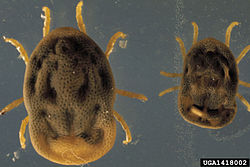| Argasidae Temporal range: | |
|---|---|
 | |
| Otobius megnini | |
| Scientific classification | |
| Kingdom: | Animalia |
| Phylum: | Arthropoda |
| Subphylum: | Chelicerata |
| Class: | Arachnida |
| Order: | Ixodida |
| Superfamily: | Ixodoidea |
| Family: | Argasidae C. L. Koch, 1844 |
| Genera | |
| Diversity | |
| 17 genera, about 220 species. | |
The Argasidae are the family of soft ticks, one of the three families of extant ticks. The family contains 220 species, although the composition of the genera is less certain, and more study is needed before the taxonomy is resolved. [1] The Argasidae are very common in South Asia, along with around 100 other species of ticks from other lineages, making South Asia the region with the highest biodiversity of ticks worldwide. [2] Soft ticks are resistant to desiccation and can live for several years in arid conditions.
